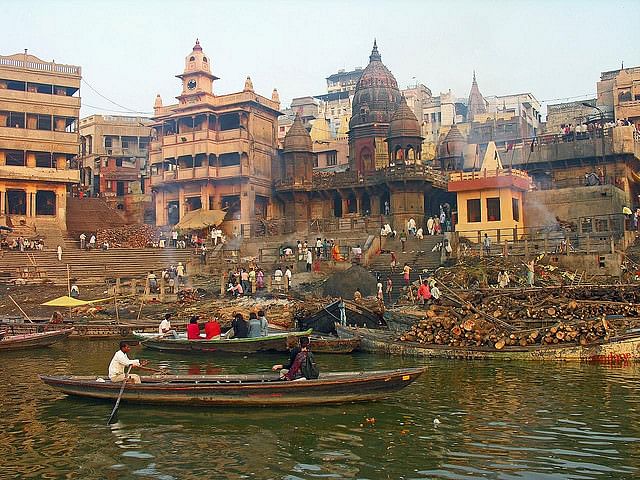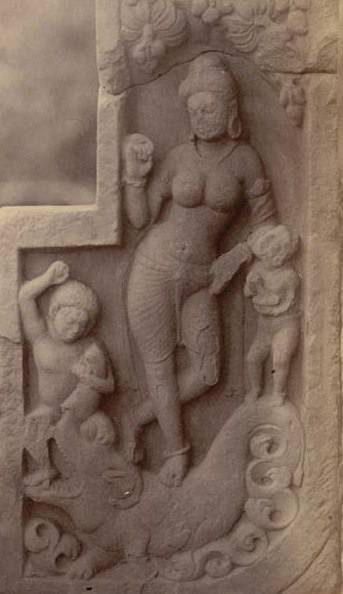Arthashastra › Ganges » Ancient origins
Articles and Definitions › Contents
- Arthashastra › Who Was
- Ganges › Antique Origins
Ancient civilizations › Historical and archaeological sites
Arthashastra › Who Was
Definition and Origins

The Arthashastra is the title of a handbook for running an empire, written by Kautilya (also known as Chanakya, c. 350-275 BCE) an Indian statesman and philosopher, chief advisor and Prime Minister of the Indian Emperor Chandragupta, the first ruler of the Mauryan Empire. The title Arthashastra is a Sanskrit word which is normally translated as The Science of Material Gain, although Science of Politics or Science of Political Economy are other accepted translations for Kautilya's work.
CONTENT
The Arthashastra summarizes the political thoughts of Kautilya. This book was lost for many centuries until a copy of it, written on palm leaves, was rediscovered in India in 1904 CE. This edition is dated to approximately 250 CE, many centuries after the time of Kautilya, but the main ideas in this book are largely his. The book contains detailed information about specific topics that are relevant for rulers who wish to run an effective government. Diplomacy and war (including military tactics) are the two points treated in most detail but the work also includes recommendations on law, prisons, taxation, irrigation, agriculture, mining, fortifications, coinage, manufacturing, trade, administrations, diplomacy, and spies.
KAUTILYA OPENLY WRITES ABOUT CONTROVERSIAL TOPICS SUCH AS ASSASSINATIONS AND HOW TO MANAGE SECRET AGENTS.
The ideas expressed by Kautilya in the Arthashastra are completely practical and unsentimental. Kautilya openly writes about controversial topics such as assassinations, when to kill family members, how to manage secret agents, when it is useful to violate treaties, and when to spy on ministers. Because of this, Kautilya is often compared to the Italian Renaissance writer Machiavelli, author of The Prince, who is considered by many as unscrupulous and immoral. It is fair to mention that Kautilya's writing is not consistently without principles in that he also writes about the moral duty of the king. He summarizes the duty of a ruler, saying, “The happiness of the subjects is the happiness of the king; their welfare is his. His own pleasure is not his good but the pleasure of his subjects is his good”. Some scholars have seen in the ideas of Kautilya a combination of Chinese Confucianism and Legalism.
Kautilya's book suggests a detailed daily schedule for how a ruler should structure his activities. According to his view, the duties of a ruler should be organized as follows:
- First 90 minutes, at sunrise, the ruler should go through the different reports (revenue, military, etc.).
- Second 90 minutes, time for public audiences.
- Third 90 minutes for breakfast and some personal time (bath, study, etc.).
- Fourth 90 minutes for meeting with ministers.
- Fifth 90 minutes for correspondence.
- Sixth 90 minutes for lunch...
Kautilya goes on to describe an exhausting schedule in which the king has roughly four and half hours to sleep and the rest of the time is almost entirely involved in running the kingdom.

Kautilya
The Arthashastra offers a list with the seven components of the state: The king, the ministers, the country (population, geography and natural resources), fortification, treasury, army, and allies. Kautilya goes on to explain each of these individual components and stresses the importance of strengthening these elements in one's kingdom and weakening them in the enemies' states by using spies and secret agents.
One of the most interesting ideas presented by Kautilya is the “ Mandala theory of interstate relations”. A mandala is a schematic visual representation of the universe, which is a common artistic expression in many Asian cultures. Kautilya explains that, if we can imagine our kingdom in the centre of a circular mandala, then the area surrounding our kingdom should be considered our enemies' territory. The circle surrounding our enemies' territories belongs to our enemies' enemies, who should be considered our allies since we will share many interests with them. The circle surrounding our enemies' enemies territory will be the allies of our enemies. Kautilya then goes on analysing twelve levels of concentric circles and offers detailed advice on how to deal with each state according to the layer they belong to in the mandala construct.
The various types of foreign policy are also explained in the Arthashastra : peace, war, neutrality, preparing for war, seeking protection and duplicity (pursuing war and peace at the same time with the same kingdom).

Mauryan Empire
LEGACY
Kautilya was a pioneer in diplomacy and government administration. His merit was based not only on
coming up with very important practical advice for government, but also in organizing his theories in a systematic and logical fashion. Kautilya's political vision had a heavy influence on Chandragupta, the first Indian ruler who unified Northern India under a single political unit for the first time in history. Even today, the Arthashastra is the number one classic of diplomacy in India and, within this category, it is one of the most complete works of antiquity. A number of institutions in India such as universities and diplomatic offices have been named after Kautilya in honour of his work. Even important political figures like Shivshankar Menon, who became the National Security Advisor of India in 2010 CE, have been influenced by Kautilya's ideas.
coming up with very important practical advice for government, but also in organizing his theories in a systematic and logical fashion. Kautilya's political vision had a heavy influence on Chandragupta, the first Indian ruler who unified Northern India under a single political unit for the first time in history. Even today, the Arthashastra is the number one classic of diplomacy in India and, within this category, it is one of the most complete works of antiquity. A number of institutions in India such as universities and diplomatic offices have been named after Kautilya in honour of his work. Even important political figures like Shivshankar Menon, who became the National Security Advisor of India in 2010 CE, have been influenced by Kautilya's ideas.
Ganges › Antique Origins
Definition and Origins

The River Ganges, also known as the Ganga, flows 2,700 km from the Himalaya mountains to the Bay of Bengal in northern India and Bangladesh. Regarded as sacred by Hindus, the river is personified as the goddess Ganga in ancient texts and art.Ritual bathing in the Ganges was and is an important part of Hindu pilgrimage and the ashes of the cremated are often spread across her waters.
THE GANGES IN SACRED TEXTS
Described in the Mahabharata as the 'best of rivers, born of all the sacred waters', the Ganges is personified as the goddess Ganga. Ganga's mother is Mena and her father is Himavat, the personification of the Himalaya mountains. In one myth Ganga marries King Sanatanu but the relationship comes to a shattering end when the goddess is discovered to have drowned her own children. In the Mahabharata Ganga is the mother of Bhishma and in some myths Skanda (Karttikeya), the Hindu god of war, is her son with Agni, the god of fire.
THE GANGES IS CONSIDERED A TIRTHA WHICH MEANS A CROSSING POINT BETWEEN HEAVEN AND EARTH.
In Hindu mythology the Ganges river was created when Vishnu, in his incarnation as the dwarf brahmin, took two steps to cross the universe. On the second step Vishnu's big toe accidentally created a hole in the wall of the universe and through it spilled some of the waters of the River Mandakini. Meanwhile, the great mythological king Bhagiratha was concerned to discover that 60,000 of King Sagara's ancestors had been incinerated from the stare of the Vedic sage Kapila. Wanting these ancestors to reach heaven, Bhagiratha asked Kapila how this might be achieved. The response was to pray earnestly to Vishnu and perform ascetic acts for a thousand years. The great god, gratified by Bhagiratha's piety, agreed for Ganga to descend to earth where she might wash over the ashes of the 60,000, purify them, and permit them to ascend to heaven.There was a problem though, that if Ganga merely dropped from heaven her swirling waters would do untold damage.Therefore, Shiva offered to gently lower the goddess in his hair which he did, rather cautiously taking 1,000 years. Safely arrived on earth, Bhagiratha guided Ganga across India, where she split into many subsidiaries, and successfully washed the ashes of Sagara's ancestors in her sacred waters.
The Ganges often appears in Hindu mythology as a background location, for example, as a place where the famous figures Atri and Death performed various acts of asceticism. In the Siva Purana the Ganges carries the seed of Shiva which, when carried to a clump of reeds, became Skanda. In the Matsya Purana and the story of the Great Flood the first man Manu throws a giant fish into the river which then continues to grow to gigantic proportions, eventually escaping to the sea.

The River Ganges
THE KUMBHA MELA & VARANASI
The Ganges is considered a tirtha which means a crossing point between heaven and earth. At a tirtha, prayers and offerings are thought most likely to reach the gods and, in the other direction, blessings can descend most readily from heaven.
The river is, along with two other sites, the location of the extraordinary Kumbha Mela ritual which dates back to at least the 7th century CE. Now held every three years, Hindu pilgrims of all social status perform a ritual bathing in the river which is thought to purify body and soul, wash away karma, and bring good fortune. The event, involving from 70 to 100 million people, grows ever bigger and can claim to be the largest human gatherings in history. Waters from the Ganges are also collected by believers and taken home for use in rituals and as an offering. Drops from the river are also dropped into the mouth before a body is cremated.
One of the most sacred sites in India is alongside the Ganges at Varanasi. Here, in one of the oldest inhabited cities in the world, there is the Hindu Golden Temple, dedicated to Shiva. The site is also sacred to Jains and Buddhists but it is perhaps most famous as a place of retirement, cremation, and the spreading of ashes upon the sacred river.

Ganga
GANGA IN ART
The goddess is often depicted in Hindu art wearing a white saree and riding a crocodile. Ganga frequently appears in sculpture near temple doors and on decorative relief panels along with her sister river goddess Yamuna. A celebrated representation of Ganga is from a sandstone lintel of a temple at Beshnagar. Dating to c. 500 CE, the goddess stands on a makara (a mythological mix of crocodile and elephant) which symbolises the life-giving nature of water.
The descent of the goddess aided by Shiva is another popular scene in art and an outstanding example is the 7th century CE granite relief panel at a cave-shrine at Mamallapuram near Madras. Measuring 24 x 6 metres, the scene shows Ganga descending in the centre surrounded by gods, people, and animals. A cistern positioned above the relief could be filled on special occasions and so water trickled down the sculpture to add some three-dimensional realism to the miracle of the great Ganges arriving on earth.
MAP
LICENSE:
Article based on information obtained from these sources:with permission from the Website Ancient History Encyclopedia
Content is available under License Creative Commons: Attribution-NonCommercial-ShareAlike 3.0 Unported. CC-BY-NC-SA License